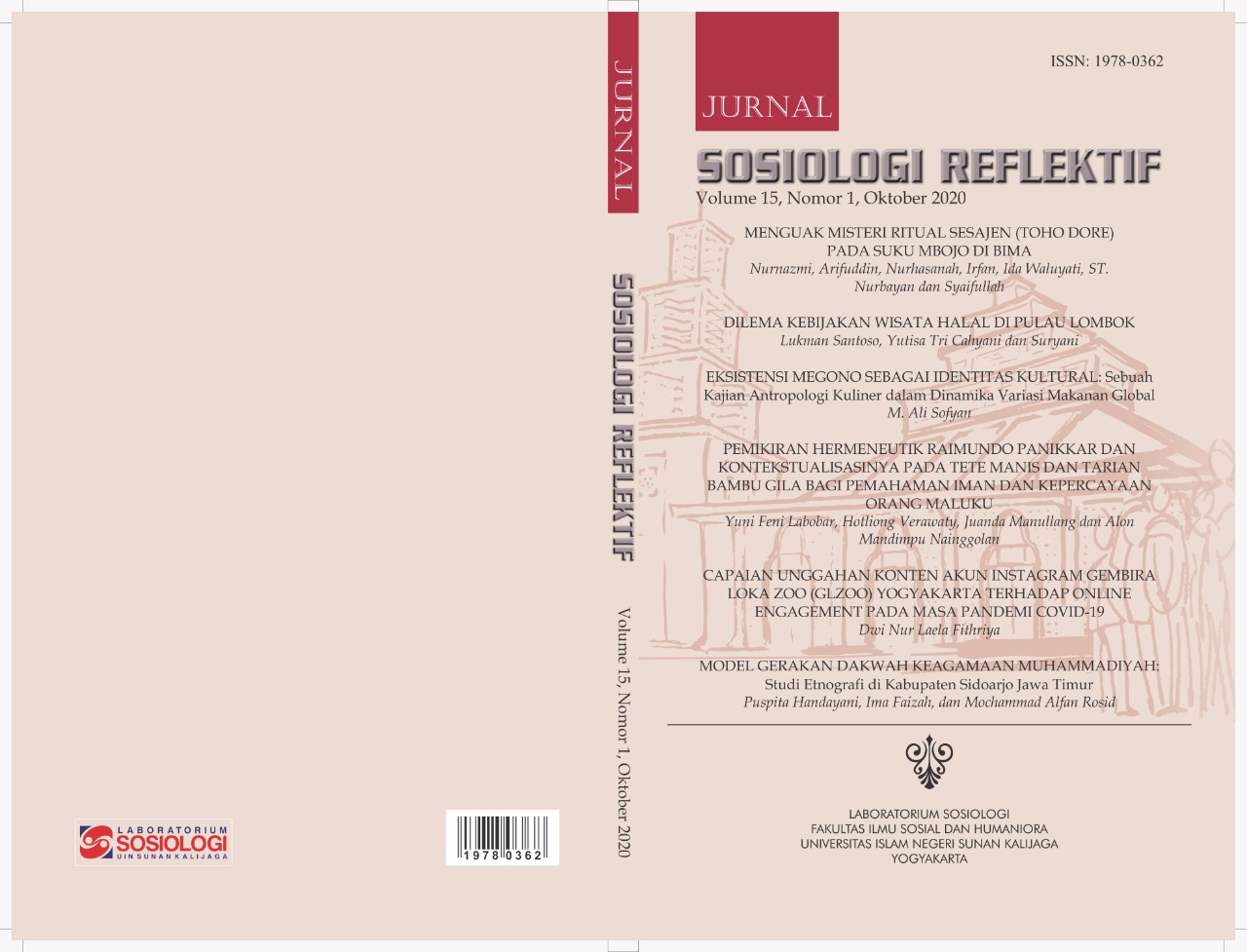CREATIVE TOURISM COMMUNITY BASED PADA KAWASAN PANTAI SUNOR LESTARI, DESA PANGKAL NIUR, KABUPATEN BANGKA (Studi terhadap Pemberdayaan Masyarakat di Komunitas Pedesaan)
License
Authors who publish with JSR agree to the following terms:- Authors retain copyright and grant the journal right of first publication with the work simultaneously licensed under a Creative Commons Attribution License that allows others to share the work with an acknowledgement of the work's authorship and initial publication in this journal.
- Authors are able to enter into separate, additional contractual arrangements for the non-exclusive distribution of the journal's published version of the work (e.g., post it to an institutional repository or publish it in a book), with an acknowledgement of its initial publication in this journal.
- Authors are permitted and encouraged to post their work online (e.g., in institutional repositories or on their website) prior to and during the submission process, as it can lead to productive exchanges, as well as earlier and greater citation of published work (See The Effect of Open Access).
How to Cite
Abstract
This study aims to explain how the community empowerment strategy carried out by the people of Pangkal Niur Village in managing and developing the Sunor Tourism area as community-based creative tourism (community-based creative tourism). The people of Pangkal Niur Village have high social capital, as manifested through their social activities and movements in building and developing the Sunor Beach area as a creative tourism. Therefore, it is interesting to make this village as a reference for the local government to be actively involved in the activities of the community as a form of preserving the environment through tourism by refusing the operation of tin mining in the area. This research uses qualitative research methods, which includes research that uses data collection techniques conducted by purposive sampling. The results of this study can be used as a basis for the village and regional governments to respond to the occurrence of illegal mining activities carried out in the Sunor Beach area. The social capital of the community is an access that can be used by the community in empowering the villagers through the management and development of Sunor Beach tourism. In addition, it is a motivation for village officials to be alert in providing assistance and facilities for people who have a high ethos in developing Sunor Beach tourism. Community empowerment is inseparable from the creativity of the community, as a form of community economic development.
Penelitian ini bertujuan untuk menjelaskan bagaimana strategi pemberdayaan masyarakat yang dilakukan oleh masyarakat Desa Pangkal Niur dalam mengelola dan mengembangkan kawasan Wisata Sunor sebagai wisata kreatif berbasis masyarakat (creative tourism community based). Masyarakat Desa Pangkal Niur memiliki modal sosial yang cukup tinggi ini terbukti dari aktivitas dan gerakan sosial yang dibangun melalui pengembangan kawasan Pantai Sunor sebagai wisata kreatif (creative tourism). Oleh karenanya kajian ini sangat menarik untuk diteliti sebagai rujukan nantinya untuk pemerintah desa dan daerah untuk terlibat atas gerakan dilakukan oleh masyarakat sebagai suatu perwujudan untuk melestarikan lingkungan melalui wisata dengan menolak beroperasinya tambang timah di kawasan tersebut. Penelitian ini menggunakan metode penelitian kualitatif, penelitian ini termasuk penelitian yang menggunakan teknik pengumpulan data yang dilakukan secara purposive sampling. Hasil penelitian ini menjadi basis bagi pemerintah desa dan daerah untuk dapat mengambil sikap terjadinya aktivitas tambang ilegal yang dilakukan di daerah kawasan Pantai Sunor. Modal sosial yang dimiliki masyarakat menjadi akses yang bisa dimanfaatkan oleh masyarakat dalam melakukan pemberdayaan melalui pengelolaan dan pengembangan wisata Pantai Sunor. Selain itu, menjadi motivasi bagi aparatur desa untuk sigap dalam memberikan bantuan dan fasilitas bagi masyarakat yang memiliki etos tinggi dalam pengembangan wisata Pantai Sunor. Pemberdayaan masyarakat yang dilakukan tentunya tidak terlepas dari kreativitas yang dilakukan oleh masyarakat sebagai wujud pembangunan ekonomi masyarakat.
Keywords:
Social Capital, Empowerment, Tourism, CreativeReferences:
Beatriz Lopez Gutierrez , A. M. Almeyda Zambrano et alLe Ecotourism: the ‘human shield’ for wildlife conservation in the Osa Peninsula, Costa Rica. Journal of Eco Tourism Pages: 197-216 Nov 2019.
Creswell, John W, Research Design Qualitative, Quantitative, and Mixed Methods Approaches”, Terj. Achmad Fawaid, Research Design Pendekatan Kualitatif, Kuantitatif, dan Mixed, Yogyakarta: Pustaka Pelajar, 2010.
Damanik, Janianton, 2013 “Pariwisata Indonesia (Antara Peluang Dan Tantangan)”, Yogyakarta, Pustaka Pelajar.
Demartoto, Argyo.2009. Pembangunan Pariwisata Berbasis Masyarakat. Sebelas Maret University Press.
Deemer, Emily. 2014. In search of the snow leopard: A new take on conservation-based ecotourism for Natural Habitat Adventures. August 2014.
Kartasasmita Ginanjar. 1995. Pemberdayaan Masyarakat Suatu Tinjauan Administrasi, Pidato Pengukuhan Jabatan Guru Besar dalam Ilmu Administrasi Fakultas Ilmu Administrasi Universitas Brwajiya ; Bandung.
Mubarak, Z. 2010. Evaluasi Pemberdayaan Masyarakat Ditinjau Dari Proses Pengembangan Kapasitas Pada Program PNPM Mandiri Perkotaan Di Desa Sastrodirjan Kabupaten Pekalongan. Tesis. Program Studi Magister Teknik Pemberdayaan Wilayah Dan Kota. Undip. Semarang.
Misztal, B. A. 2003. Durkheim on Collective Memory. Journal of Classical Sociology, 3(2), 123–143.
Pranarka dan Vidhyandika, 1996. Pemberdayaan dalam Onny S.P dan AMW. Pranarka (ed). 1996. Pemberdayaan: Konsep, Kebijakan dan Implementasi. Jakarta: Center for Strategic and International Studies (CSIS).
Reid, Anthony. 2009. Imperial Alchemy_Nationalism and Political Identity in Southeast Asia. Cambridge University Press. 2009.
Slamet, M. 2003. Pemberdayaan Masyarakat. Dalam Membetuk Pola Perilaku Manusia Pembangunan. Disunting oleh Ida Yustina dan Adjat Sudradjat. Bogor: IPB Press.
Sumardjo. 2010. Model Pemberdayaan Masayarakat Dan Pengelolaan Konflik Sosial Pada Perkebunan Kelapa Sawit Di Propinsi Riau. Riau. 287 Hal.
Walter, Pierre. 2019. Community-based ecotourism projects as living museums. Journal of Eco Tourism, Pages: 233-247 Nov 2019.
Woolcock, Michael and Deepa Narayan. 2006. Social Capital: Implication for Development Theory, Research, and Policy Revisted. In Bebbington, Anthony; M. Woolcock; Scott E.G.; and Elizabeth A. Olson: The Search for Empowerment: Social Capital as Idea and Practice at the World Bank. Kumarian Press, Inc. USA

